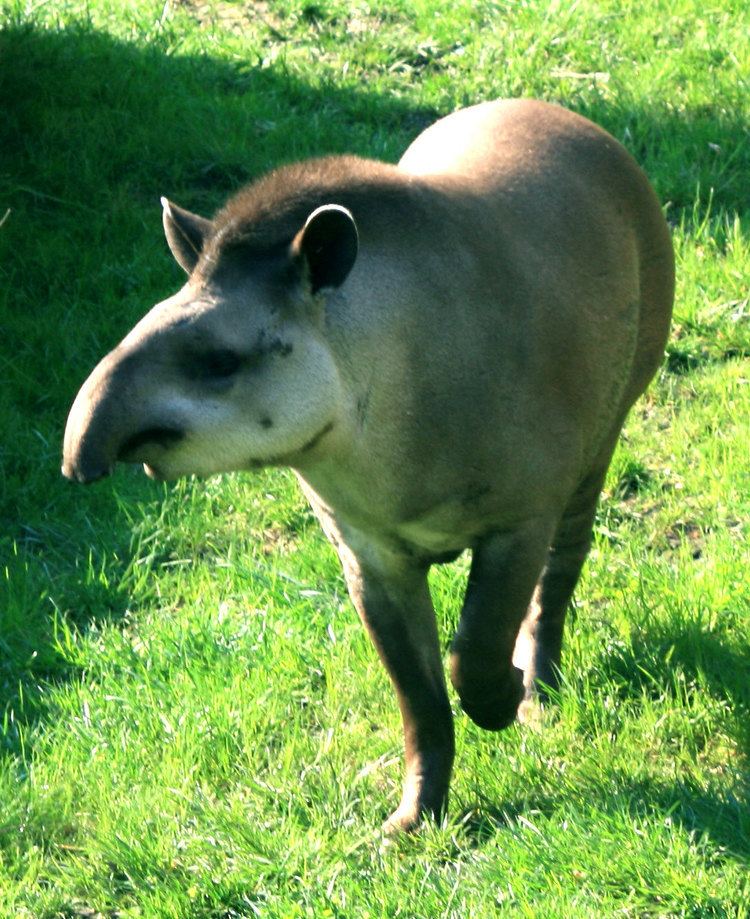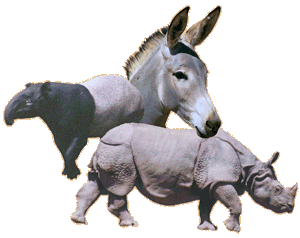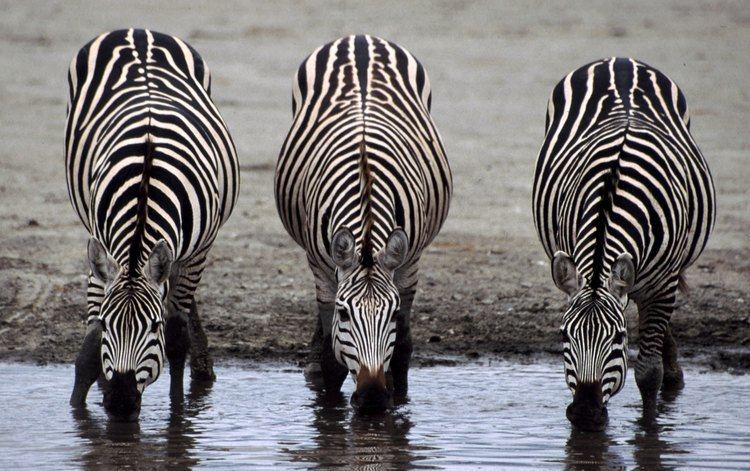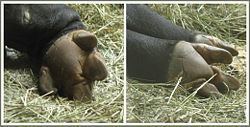Kingdom Animalia Clade Euungulata Higher classification Mammal | Phylum Chordata Scientific name Perissodactyla | |
Order PerissodactylaOwen, 1848 Mass Horse: 380 – 1,000 kg, White rhinoceros: 2,300 kg Lifespan Horse: 25 – 30 years, White rhinoceros: 40 – 50 years, Black rhinoceros: 35 – 50 years Height Horse: 1.4 – 1.8 m, White rhinoceros: 1.7 – 1.8 m, Black rhinoceros: 1.3 – 1.8 m, Indian rhinoceros: 1.6 – 1.9 m Length Horse: 2.4 m, White rhinoceros: 3.7 – 4 m Lower classifications Horses, Rhinoceros, Tapir, Brontotheriidae, Chalicothere | ||
Members of the order Perissodactyla, otherwise known as odd-toed ungulates, are mammals characterized by an odd number of toes and by hindgut fermentation with somewhat simple stomachs. Perissodactyla comes from the Ancient Greek περισσός (perissós, “uneven”) + δάκτυλος (dáktulos, “a finger, toe”). Unlike the even-toed ungulates, they digest plant cellulose in their intestines rather than in one or more stomach chambers. The order includes three extant families: Equidae (horses, donkeys, and zebras), Rhinocerotidae (rhinos) and Tapiridae (tapirs), with a total of about 17 species. In spite of their very different appearance, they were recognized as related families in the 19th century by the zoologist Richard Owen, who also coined the order name.
Contents
- Anatomy
- Limbs
- Skull and teeth
- Gut
- Distribution
- Lifestyle and diet
- Reproduction and development
- Outer taxonomy
- Modern members
- Prehistoric members
- Higher classification of perissodactyls
- Origins
- Phylogeny
- Research history
- Interactions with humans
- References

Anatomy

The largest odd-toed ungulates are rhinoceroses, and the extinct Paraceratherium, a hornless rhino from the Oligocene, is considered one of the largest land mammals of all time. At the other extreme, an early member of the order, the prehistoric horse Hyracotherium, had a shoulder height of only 30 to 60 cm (12 to 24 in). Apart from dwarf varieties of the domestic horse and donkey, perissodactyls reach a body length of 180–420 cm (71–165 in) and a weight of 150 to 3,500 kg (330 to 7,720 lb). While rhinos have only sparse hair and exhibit a thick epidermis, tapirs and horses have a dense, short coat. Most species are grey or brown, although zebras and young tapirs are striped.
Limbs
The main axes of both the front and rear feet pass through the third toe, which is always the largest. The remaining toes have been reduced in size to varying degrees. Tapirs, which are adapted to walking on soft ground, have four toes on their forefeet and three on their hindfeet. Living rhinos have three toes on both the front and hind feet. Modern equines possess only a single toe; however, their feet are equipped with hooves, which almost completely cover the toe. Rhinos and tapirs, by contrast, have hooves covering only the leading edge of the toes, with the bottom being soft.
The ulna and fibula are reduced in horses. A common feature that clearly distinguishes this group from other mammals is the saddle-shaped ankle between the astragalus and the scaphoid, which greatly restricts the mobility of the foot. The thigh is relatively short, and the clavicle is absent.
Skull and teeth

Odd-toed ungulates have a long upper jaw with an extended diastema between the front and cheek teeth, giving them an elongated head. The various forms of snout between families are due to differences in the form of the premaxilla. The lacrimal bone has projecting cusps in the eye sockets and a wide contact with the nasal bone. The temporomandibular joint is high and the mandible is enlarged.

Rhinos have one or two horns made of agglutinated keratin, unlike the horns of even-toed ungulates, which have a bony core.
The number and form of the teeth vary according to diet. The incisors and canines can be very small or completely absent, as in the two African species of rhinoceros. In the horses, usually only the males possess canines. The surface shape and height of the molars is heavily dependent on whether soft leaves or hard grass makes up the main component of their diet. Three or four cheek teeth are present on each jaw half, so the dental formula of odd-toed ungulates is: 0-3 . 0-1 . 2-4 . 31-3 . 1 . 2-4 . 3 × 2 = 30-44
Gut
All perissodactyls are hindgut fermenters. In contrast to ruminants, hindgut fermenters store digested food that has left the stomach in an enlarged cecum, where the food is digested by bacteria. No gallbladder is present. The stomach of perissodactyls is simply built, while the cecum accommodates up to 90 litres (24 US gal) in horses. The intestine is very long, reaching up to 26 metres (85 ft) in horses. Extraction of nutrients from food is relatively inefficient, which probably explains why there are no small odd-toed ungulates; for large animals nutritional requirements per kilogram of body weight are lower and the surface-to-volume ratio is smaller.
Distribution
The present distribution of most perissodactyl species is only a small fraction of their original range. Members of this group are now found only in Central and South America, in eastern and southern Africa, and in central, southern, and southeastern Asia. During the peak of odd-toed ungulate existence, from the Eocene to the Oligocene, perissodactyls were distributed over much of the globe, the only exceptions being Australia and Antarctica. Horses and tapirs arrived in South America after the formation of the Isthmus of Panama in the Pliocene, around 3 million years ago. In North America, they died out around 10,000 years ago, while in Europe the tarpans disappeared in the 19th century. Hunting and habitat restriction have reduced the present-day species to fragmented relict populations. In contrast, domesticated horses and donkeys have gained a worldwide distribution, and feral animals of both species are now also found in regions outside of their original range, such as in Australia.
Lifestyle and diet
Perissodactyls inhabit a number of different habitats, leading to different lifestyles. Tapirs are solitary and inhabit mainly tropical rainforests. Rhinos tend to live alone in rather dry savannas and, in Asia, wet marsh or forest areas. Horses inhabit open areas such as grasslands, steppes, or semi-deserts and live together in groups. Odd-toed ungulates are exclusively herbivores that feed, to varying degrees, on grasses, leaves and other plant parts. A distinction is often made between primarily grass feeders (white rhinos, equines) and leaf feeders (tapirs, other rhinos).
Reproduction and development
Odd-toed ungulates are characterized by a long gestation period and a small litter size, usually delivering a single young. The gestation period is 330–500 days, being longest in the rhinos. Newborn perissodactyls are precocial; young horses and rhinos can follow the mother after a few hours. Infants are nursed for a relatively long time, often into their second year, reaching sexual maturity at around eight or ten years. Perissodactyls are long-lived, with several species reaching an age of almost 50 years in captivity.
Outer taxonomy
Traditionally, the odd-toed ungulates were classified with other mammals such as artiodactyls, hyraxes, mammals with a proboscis, and other "ungulates". A close family relationship with hyraxes was suspected based on similarities in the construction of the ear and the course of the carotid artery.
Recent molecular genetic studies, however, have shown the ungulates to be polyphyletic, meaning that in some cases the similarities are the result of convergent evolution rather than common ancestry. Elephants and hyraxes are now considered to belong to Afrotheria and are therefore not closely related to the perissodactyls. These, in turn, are in Laurasiatheria, a superorder that had its origin in the former supercontinent Laurasia. Molecular genetic findings suggest that the cloven Artiodactyla (containing the cetaceans as a deeply nested subclade) is the sister taxon of the Perissodactyla; together, the two groups form the Euungulata. More distant are the bats (Chiroptera) and Ferae (a common taxon of carnivorans, Carnivora, and pangolins, Pholidota). In a discredited alternative scenario, there is a close relationship between perissodactyls, carnivores and bats (chiroptera), this assembly comprising the Pegasoferae.
According to studies published in March 2015, odd-toed ungulates are in a close family relationship with at least some of the so-called Meridiungulata, a very diverse group of mammals living from the Paleocene to the Pleistocene in South America whose systematic unity is largely unexplained. Some of these were classified on the basis of their paleogeographic distribution. However, a close relationship can be worked out to perissodactyls by means of protein sequencing and comparison with fossil collagen from remnants of phylogenetically young members of Meridiungulata (specifically Macrauchenia from the Litopterna and Toxodon from the Notoungulata). Both kinship groups, the odd-toed ungulates and the Litopterna-Notoungulata, are now in the higher-level taxon of Panperissodactyla. This kinship group is included among the Euungulata which also contains the even-toed ungulates and whales (Artiodactyla). The separation of the Litopterna-Notoungulata group from the perissodactyls probably took place before the Cretaceous-Paleogene extinction event. "Condylarths" can probably be considered the starting point for the development of the two groups, as they represent a heterogeneous group of primitive ungulates that mainly inhabited the northern hemisphere in the Paleogene.
Modern members
Odd-toed ungulates (Perissodactyla) comprise three living families with around 17 species—in the horse the exact count is still controversial. Rhinos and tapirs are more closely related to each other than to the horses. The separation of horses from other perissodactyls took place according to molecular genetic analysis in the Paleocene some 56 million years ago, while the rhinos and tapirs split off in the lower middle Eocene, about 47 million years ago.
Prehistoric members
There are many perissodactyl fossils of multivariant form. The major lines of development include the following groups:
Higher classification of perissodactyls
Relationships within the large group of odd-toed ungulates are not fully understood. Initially, after the establishment of the concept "Perissodactyla" by Richard Owen in 1848, the present-day representatives were considered equal in rank. In the first half of the 20th century, a more systematic differentiation of odd-toed ungulates began, based on a consideration of fossil forms, and they were placed in two major suborders: Hippomorpha and Ceratomorpha. The Hippomorpha comprises today's horses and their extinct members (Equoidea); the Ceratomorpha consist of tapirs and rhinos plus their extinct members (Tapiroidea and Rhinocerotoidea). The names Hippomorpha and Ceratomorpha were introduced in 1937 by Horace Elmer Wood, in response to criticism of the name "Solidungula" that he proposed three years previously. It had been based on the grouping of horses and Tridactyla and on the rhinoceros/tapir complex. The extinct brontotheriidae were also classified under Hippomorpha and therefore possess a close relationship to horses. Some researchers accept this assignment because of similar dental features, but there is also the view that a very basal position within the odd-toed ungulates places them rather in the group of Titanotheriomorpha.
Originally, the Chalicotheriidae were seen as members of Hippomorpha, and presented as such in 1941. William Berryman Scott thought that, as claw-bearing perissodactyls, they belong in the new suborder Ancylopoda (where Ceratomorpha and Hippomorpha as odd-toed ungulates were combined in the group of Chelopoda). The term Ancylopoda, coined by Edward Drinker Cope in 1889, had been established for chalicotheres. However, further morphological studies from the 1960s showed a middle position of Ancylopoda between Hippomorpha and Ceratomorpha. Leonard Burton Radinsky saw all three major groups of odd-toed ungulates as peers, based on the extremely long and independent phylogenetic development of the three lines. In the 1980s, Jeremy J. Hooker saw a general similarity of Ancylopoda and Ceratomorpha based on dentition, especially in the earliest members, leading to the unification in 1984 of the two submissions in the interim order, Tapiromorpha. At the same time he expanded the Ancylopoda to include the Lophiodontidae. The name "Tapiromorpha" goes back to Ernst Haeckel, who coined it in 1873, but it was long considered synonymous to Ceratomorpha because Wood had not considered it in 1937 when Ceratomorpha were named, since the term had been used quite differently in the past. Also in 1984, Robert M. Schoch used the conceptually similar term Moropomorpha, which today applies synonymously to Tapiromorpha. Within the Tapiromorpha are included the now extinct Isectolophidae, a sister group of the Ancylopoda-Ceratomorpha group and thus the most primitive members of this relationship complex.
Origins
The evolutionary development of Perissodactyla is well documented in the fossil record. Numerous finds are evidence of the adaptive radiation of this group, which was once much more varied and widely dispersed. Radinskya from the late Paleocene of East Asia is often considered to be one of the oldest close relatives of the ungulates. Its only 8 cm skull must have belonged to a very small and primitive animal with a π-shaped crown pattern on the enamel of its rear molars similar to that of perissodactyls and their relatives, especially the rhinos. Finds of Cambaytherium and Kalitherium in the Cambay shale of western India indicate an origin in Asia dating to the Lower Eocene roughly 54.5 million years ago. Their teeth also show similarities to Radinskya as well as to the Tethytheria clade. The saddle-shaped configuration of the navicular joints and the mesaxonic construction of the front and hind feet also indicates a close relationship to Tethytheria. However, this construction deviates from that of Cambaytherium, indicating that it is actually a member of a sister group. Ancestors of Perissodactyla may have arrived via an island bridge from the Afro-Arab landmass onto the Indian subcontinent as it drifted north towards Asia.
The alignment of hyopsodontids and phenacodontids to Perissodactyla in general suggests an older Laurasian origin and distribution for the clade, dispersed across the northern continents already in the early Paleocene. These forms already show a fairly well-developed molar morphology, with no intermediary forms as evidence of the course of its development. The close relationship between meridiungulate mammals and perissoodactyls in particular is of interest since the latter appear in South America soon after the KT event, implying rapid ecological radiation and dispersal after the mass extinction.
Phylogeny
The Perissodactyla appear relatively abruptly at the beginning of the Lower Paleocene before about 63 million years ago, both in North America and Asia, in the form of phenacodontids and hyopsodontids. The oldest finds from an extant group originate among other sources from Sifrhippus, an ancestor of the horses from the Willswood lineup in northwestern Wyoming. The distant ancestors of tapirs appeared not too long after that in the Ghazij lineup in Balochistan, such as Ganderalophus, as well as Litolophus from the Chalicotheriidae line, or Eotitanops from the group of brontotheriidae. Initially, the members of the different lineages looked quite similar with an arched back and generally four toes on the front and three on the hind feet. Hyracotherium, which is considered a member of the horse family, outwardly resembled Hyrachyus, the first representative of the rhino and tapir line. All were small compared to later forms and lived as fruit and foliage eaters in forests. The first of the mega-fauna to emerge were the brontotheres, in the Middle and Upper Eocene. Megacerops, known from North America, reached a shoulder height of 2.5 metres (8.2 ft) and could have weighed just over 3 metric tons (3.3 short tons). The decline of brontotheres at the end of the Eocene is associated with competition arising from the advent of more successful herbivores.
More successful lines of odd-toed ungulates emerged at the end of the Eocene when dense jungles gave way to steppe, such as the chalicotheriid rhinos, and their immediate relatives; their development also began with very small forms. Paraceratherium, one of the largest mammals ever to walk the earth, evolved during this era. They weighed up to 20 metric tons (22 short tons) and lived throughout the Oligocene in Eurasia. About 20 million years ago at the onset of the Miocene the perissodactyls first reached Africa when it became connected to Eurasia because of the closing of the Tethys Ocean. For the same reason, however, new animals such as the mammoths also entered the ancient settlement areas of odd-toed ungulates, creating competition that led to the extinction of some of their lines. The rise of ruminants, which occupied similar ecological niches and had a much more efficient digestive system, is also associated with the decline in diversity of odd-toed ungulates. A significant cause for the decline of perissodactyls was climate change during the Miocene, leading to a cooler and dryer climate accompanied by the spread of open landscapes. However, some lines flourished, such as the horses and rhinos; anatomical adaptations made it possible for them to consume tougher grass food. This led to open land forms that dominated the newly created landscapes. With the emergence of the Isthmus of Panama in the Pliocene, perissodactyls and other megafauna were given access to one of their last habitable continents: South America. However, many perissodactyls became extinct at the end of the ice ages, including American horses and the Elasmotherium. Whether over-hunting by humans (overkill hypothesis), climatic change, or a combination of both factors was responsible for the extinction of ice age mega-fauna, remains controversial.
Research history
In 1758, in his seminal work Systema Naturae, Linnaeus (1707–1778) classified horses (Equus) together with hippos (Hippopotamus). At that time, this category also included the tapirs (Tapirus), more precisely the lowland or South American tapir (Tapirus terrestus), the only tapir then known in Europe. Linnaeus classified this tapir as Hippopotamus terrestris and put both genera in the group of the Belluae ("beasts"). He combined the rhinos with the Glires, a group now consisting of the lagomorphs and rodents. Mathurin Jacques Brisson (1723–1806) first separated the tapirs and hippos in 1762 with the introduction of the concept le tapir. He also separated the rhinos from the rodents, but did not combine the three families now known as the odd-toed ungulates. In the transition to the 19th century, the individual perissodactyl genera were associated with various other groups, such as the proboscidean and even-toed ungulates. In 1795, Étienne Geoffroy Saint-Hilaire (1772- 1844) and Georges Cuvier (1769–1832) introduced the term "pachyderm" (Pachydermata), including in it not only the rhinos and elephants, but also the hippos, pigs, peccaries, tapirs and hyrax . The horses were still generally regarded as a group separate from other mammals and were often classified under the name Solidungula or Solipèdes, meaning "one-hoof animal".
In 1861, Henri Marie Ducrotay de Blainville (1777–1850) classified ungulates by the structure of their feet, differentiating those with an even number of toes from those with an odd number. He moved the horses as solidungulate over to the tapirs and rhinos as multungulate animals and referred to all of them together as onguligrades à doigts impairs, coming close to the concept of the odd-toed ungulate as a systematic unit. Richard Owen (1804–1892) quoted Blainville in his study on fossil mammals of the Isle of Wight and introduced the name Perissodactyla.
In 1884, Othniel Charles Marsh (1831–1899) came up with the concept Mesaxonia, which he used for what are today called the odd-toed ungulates, including their extinct relatives, but explicitly excluding the hyrax. Mesaxonia is now considered a synonym of Perissodactyla, but it was sometimes also used for the true odd-toed ungulates as a subcategory (rhinos, horses, tapirs), while Perissodactyla stood for the entire order, including the hyrax. The assumption that hyraxes were Perissodactyla was held well into the 20th century. Only with the advent of molecular genetic research methods had it been recognized that the hyrax is not closely related to perissodactyls but rather to elephants and manatees.
Interactions with humans
The domestic horse and the donkey play an important role in human history particularly as transport, work and pack animals. The domestication of both species began several millennia B.C. Due to the motorisation of agriculture and the spread of automobile traffic, such use has declined sharply in Western industrial countries; riding is usually undertaken more as a hobby or sport. In less developed regions of the world, the traditional uses for these animals are, however, still widespread. To a lesser extent, horses and donkeys are also kept for their meat and their milk.
In contrast, the existence in the wild of almost all other odd-toed ungulates species has declined dramatically because of hunting and habitat destruction. The quagga is extinct and Przewalski's horse has been eradicated in the wild.
Present threat levels, according to the International Union for Conservation of Nature (2012):
